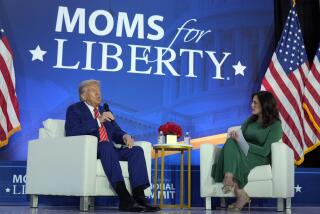What’s in a Name? Japanese Identity
Hiroshi Yamagiwa is waging a quiet rebellion--with his business card.
Like many of his colleagues, the newspaperman’s name and credentials are written in Japanese on the front, English on the back.
But there’s something different about this card that reveals something about cultural pride and a search for identity in a globalizing world of sameness.
On the English side, it reads family name first, given name last--the same as in Japanese. A seemingly trivial detail, the word order flouts a decades-old custom of flipping names in their English version to make them easier for Westerners to understand.
For people like Hiroshi Yamagiwa--or should that be Yamagiwa Hiroshi?--it’s a matter of cultural pride.
“Koreans and Chinese use their names properly. So why not Japanese?” he said.
The custom of reversing names for Western consumption dates back to the 1880s, when Japan was racing to catch up with the United States and Europe, and has found its way into business cards, English-language textbooks, newspaper articles like this one.
Like his predecessors, Japan’s prime minister comes in two versions: Mori Yoshiro at home, and Yoshiro Mori when traveling abroad or mentioned in the Western press.
But change is in the air.
The Education Ministry recommended in September that foreign-language textbooks, government publications and newspapers start using the Japanese word order.
It’s not compulsory, but since textbooks must be approved by the ministry, many publishers are likely to comply. Government agencies are expected to gradually follow suit. Newspaper editors will act on their own discretion.
“In the global society, it’s important for countries to preserve their own culture,” said Education Ministry official Toshio Nomura. “The thinking is that Japanese should show the world their names in their original form.”
Many Japanese scholars stick with the non-Western name order when publishing international papers.
“People are starting to realize now that there is a Japanese way, that there’s no need to imitate foreigners,” said Takayuki Okutomi, a professor at Nippon Medical School who published a book about the history of Japanese names.
The Chinese stick to their ways (President Jiang Zemin’s surname is Jiang), so why not us? many Japanese are asking.
One publishing company has begun using the Japanese name order in its English-language textbooks, and others are considering it.
“International society has long been dominated by the customs of the United States and Europe,” said Takeshi Enomoto of Kairyudo Publishing Co., which is mulling the change. “Now it’s easier for people to accept various customs.”
Still, critics and supporters alike agree it will be hard to change a system that has been instilled in most Japanese since their grade-school English classes. And detractors say the effort and money should be spent on more pressing needs.
If the change does take root, Westerners will have to be careful lest they inadvertently go on first-name terms with Japanese based on a glance at a business card.
Hoping to spare his Western acquaintances any such awkwardness. Yamagiwa prints his surname on his card in capitals: “YAMAGIWA Hiroshi.”
Even Enomoto, a staunch traditionalist when it comes to names, admits to introducing himself in the Western style when meeting foreigners or traveling overseas.
“It’s just easier for Westerners to understand,” he said.
More to Read
Sign up for Essential California
The most important California stories and recommendations in your inbox every morning.
You may occasionally receive promotional content from the Los Angeles Times.






